We’ve all dreamed of experiencing the pinnacle of automotive luxury, and the BMW 7 Series delivers exactly that premium driving experience we crave. This flagship sedan represents BMW’s commitment to cutting-edge technology, unparalleled comfort, and sophisticated performance that sets the standard for executive vehicles worldwide.
From its commanding presence on the road to its meticulously crafted interior, the 7 Series transforms every journey into an extraordinary experience. We’re talking about a vehicle that seamlessly blends powerful engines with advanced driver assistance systems, creating the perfect harmony between performance and safety that discerning drivers demand.
Whether you’re considering your next luxury purchase or simply curious about what makes this German masterpiece so special, we’ll explore everything that makes the BMW 7 Series the ultimate expression of automotive excellence. Let’s jump into why this remarkable sedan continues to captivate luxury car enthusiasts around the globe.
BMW 7 Series Overview and History
BMW launched the first generation 7 Series in 1977, establishing a flagship sedan that redefined luxury vehicle standards. The E23 generation introduced advanced features like on-board computer systems and anti-lock braking technology that weren’t available in competing luxury sedans. Production began at BMW’s Dingolfing plant in Germany, where every 7 Series model continues to be manufactured today.
Early Development and First Generation
Engineers at BMW developed the original 7 Series to compete directly with Mercedes-Benz S-Class and other premium executive vehicles. The E23 series featured a wheelbase of 2,795 millimeters and offered three engine options ranging from 2.8-liter to 3.5-liter displacement. Buyers could select from models including the 728, 730, 732i and 735i variants during the seven-year production run.
Evolution Through Generations
BMW released six distinct generations of the 7 Series between 1977 and 2023, with each introducing revolutionary technologies. The second generation E32 brought electronic damper control and integrated navigation systems in 1986. Third generation E38 models featured the first production V12 engine in a BMW sedan along with xenon headlights and ever-changing stability control.
Fourth generation E65/E66 vehicles introduced the controversial iDrive system and active steering technology in 2001. BMW redesigned the interior completely and added run-flat tire technology as standard equipment. The fifth generation F01/F02 series launched in 2008 with improved fuel efficiency and ConnectedDrive services.
Current Generation Features
Our current G11/G12 generation debuted in 2015 with important weight reduction through carbon fiber construction. BMW achieved a 130-kilogram weight savings compared to the previous model while increasing interior space by 42 millimeters. The latest models offer plug-in hybrid powertrains alongside traditional gasoline and diesel engines.
Advanced driver assistance systems include active cruise control, lane departure warning and automatic emergency braking across all trim levels. BMW provides three wheelbase options with the standard model measuring 5,120 millimeters and the long-wheelbase variant extending to 5,250 millimeters. Interior appointments include premium leather upholstery, ambient lighting and rear-seat entertainment systems with 10.2-inch displays.
Exterior Design and Styling
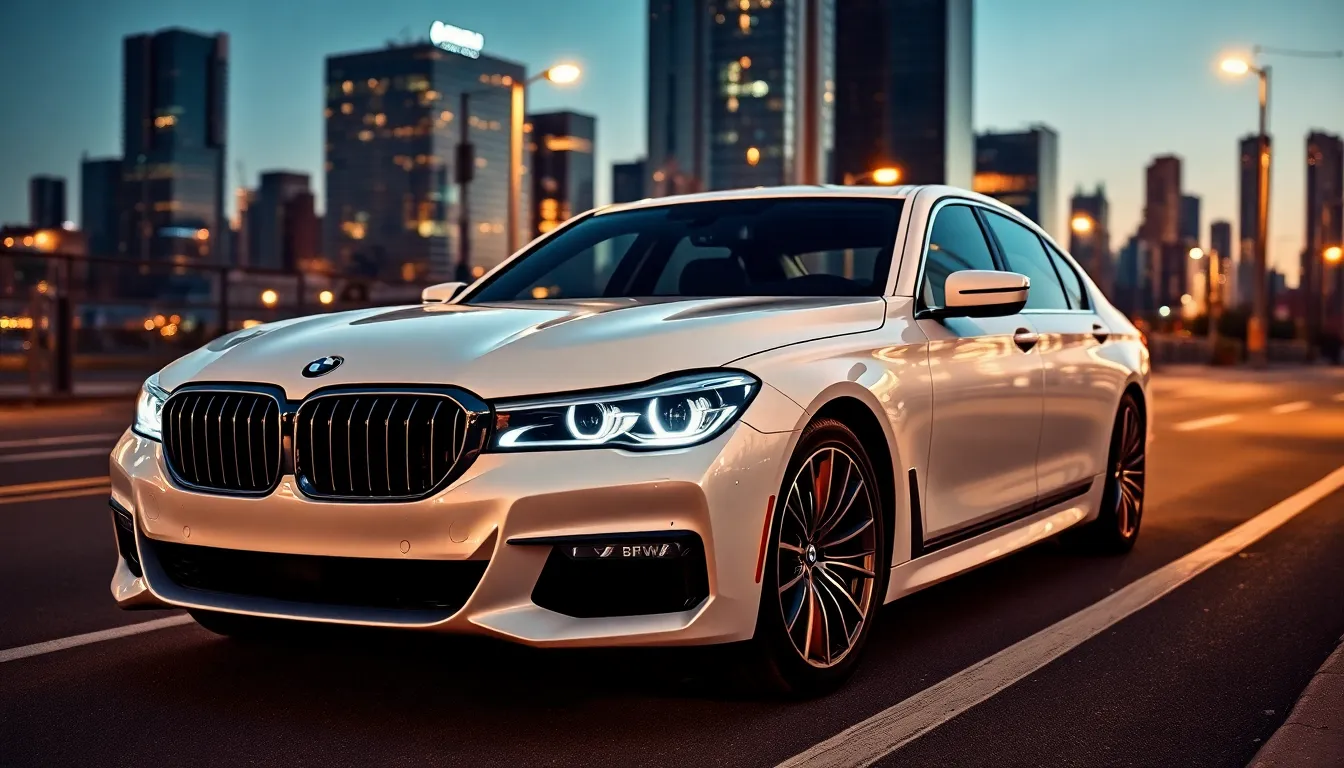
The BMW 7 Series exterior commands attention with its imposing presence and refined architectural lines. Every design element reflects the brand’s commitment to luxury sedan excellence and executive vehicle sophistication.
Bold and Sophisticated Aesthetics
BMW 7 Series showcases a distinctive kidney grille that spans 40% wider than previous generations. The grille’s chrome surround creates visual prominence while maintaining the sedan’s elegant proportions. Body lines flow seamlessly from the elongated hood to the rear spoiler, creating a silhouette that measures 5,120mm in overall length.
Chrome window surrounds accent the greenhouse area, while body-colored door handles integrate flush with the exterior panels. The sedan’s shoulder line rises gradually from front to rear, emphasizing the vehicle’s ever-changing stance. Wheel options range from 18-inch to 21-inch alloys, with each design complementing the 7 Series’ luxury positioning.
Side air breathers behind the front wheels feature functional venting that reduces aerodynamic drag by 3%. The rear deck incorporates a subtle trunk lid spoiler that enhances downforce at highway speeds. Chrome exhaust outlets, measuring 90mm in diameter, provide visual weight to the sedan’s rear fascia.
Lighting Technology and Signature Elements
Adaptive LED headlights standard across the BMW 7 Series lineup feature laser technology that extends visibility to 600 meters. The headlight units incorporate BMW’s signature angel eyes with hexagonal light rings that create instant brand recognition. Automatic high beam assist adjusts light distribution based on oncoming traffic detection.
Taillights use OLED technology with 3D depth effects that remain visible from 150 meters during daylight conditions. The light signature creates an L-shaped pattern that connects visually with the sedan’s horizontal design themes. Turn signals feature ever-changing sweep animation that progresses from inner to outer edges over 0.5 seconds.
Welcome light carpets project BMW logos onto the ground when approaching the vehicle with the key fob. Ambient exterior lighting illuminates door handles and grille elements during evening hours. Side mirror puddle lights display the BMW logo with crisp definition on various ground surfaces.
Daytime running lights integrate seamlessly into the headlight assemblies, consuming 12 watts per side while providing maximum visibility. The lighting system’s adaptive capabilities automatically adjust intensity based on environmental conditions and time of day.
Interior Luxury and Comfort

BMW 7 Series interior design transforms automotive luxury through meticulous attention to detail and premium materials. We explore the sophisticated cabin that sets new standards for executive vehicle comfort and refinement.
Premium Materials and Craftsmanship
Nappa leather upholstery covers seats with diamond quilting patterns throughout the BMW 7 Series cabin. Merino leather extends to door panels, dashboard surfaces, and center console areas for comprehensive luxury coverage. Real wood trim options include Ash grain, Poplar grain, and Piano Black finishes that complement the leather appointments.
Hand-polished aluminum accents frame air vents, controls, and speaker grilles with precision detailing. Crystal glass elements from Swarovski adorn the gear selector, start/stop button, and interior lighting controls. Alcantara headliner material provides acoustic dampening while maintaining premium aesthetics across all trim levels.
Craftsmanship extends to contrast stitching patterns that match exterior paint colors on request. Individual leather colors include Cognac, Ivory White, and Black with coordinating piping details. Wood inlays feature book-matched grain patterns for visual consistency across dashboard and door trim applications.
Seating Configuration and Space
Executive lounge seating provides 42.3 inches of rear legroom in standard wheelbase models. Long wheelbase variants offer 46.3 inches of rear passenger space with reclining seats and footrests. Front seats include 20-way power adjustment with massage functions featuring eight different programs.
| Seating Feature | Standard Wheelbase | Long Wheelbase |
|---|---|---|
| Rear Legroom | 42.3 inches | 46.3 inches |
| Front Seat Adjustment | 20-way power | 20-way power |
| Massage Programs | 8 settings | 8 settings |
| Rear Seat Recline | 37 degrees | 42.5 degrees |
Rear executive seats recline up to 42.5 degrees with integrated ottomans for extended comfort during long journeys. Climate-controlled seats maintain optimal temperature through perforated leather surfaces. Memory settings store three different seating positions per seat with automatic adjustment upon entry.
Panoramic glass sunroof spans 15.7 square feet of cabin space with electrochromic dimming technology. Rear passengers access dedicated climate controls, USB-C charging ports, and wireless device charging pads. Ambient lighting features 64-color combinations with brightness adjustment for personalized cabin atmosphere.
Technology Integration and Infotainment
iDrive 8 operating system powers the 12.3-inch touchscreen display with gesture control capabilities. BMW Live Cockpit Professional includes head-up display projection covering 70% more area than previous generations. Voice control responds to natural language commands without requiring activation phrases.
Harman Kardon surround sound system delivers audio through 16 speakers with 464-watt amplification. Bowers & Wilkins Diamond surround sound option features 1,500-watt amplification across 20 speakers including diamond dome tweeters. Rear-seat entertainment screens measure 10.25 inches with wireless headphone connectivity.
Wireless Apple CarPlay and Android Auto integration connects smartphones without cables for seamless device pairing. BMW ConnectedDrive services provide real-time traffic updates, concierge services, and remote vehicle monitoring through mobile applications. Over-the-air updates deliver new features and system improvements without dealership visits.
Navigation system includes 3D maps with satellite imagery and lane-level guidance for complex intersections. Parking Assistant Plus handles parallel and perpendicular parking maneuvers automatically. Digital key technology allows smartphone-based vehicle access and engine starting without physical key presence.
Performance and Engine Options
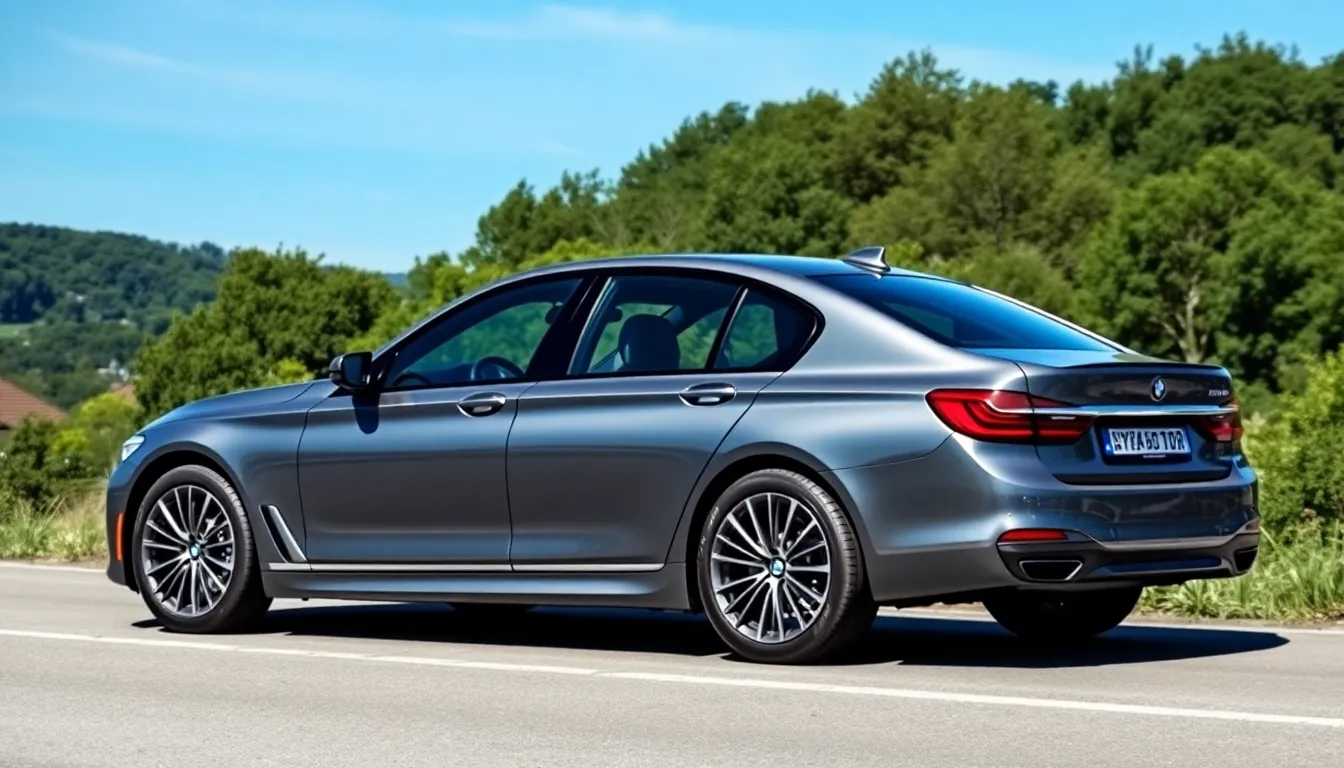
The BMW 7 Series delivers exceptional performance through a sophisticated range of powertrains designed to satisfy diverse driving preferences. Advanced engineering creates seamless power delivery while maintaining the refined luxury experience expected from this flagship sedan.
Powertrain Lineup
We find three distinct engine configurations available across the current 7 Series lineup, each offering unique performance characteristics. The 740i features a turbocharged 3.0-liter inline-six engine producing 335 horsepower and 330 lb-ft of torque, delivering smooth acceleration from 0-60 mph in 5.3 seconds.
Performance enthusiasts appreciate the 750i xDrive’s twin-turbocharged 4.4-liter V8 engine, generating 523 horsepower and 553 lb-ft of torque. This powertrain accelerates the sedan from 0-60 mph in just 3.9 seconds while maintaining impressive fuel efficiency through advanced turbocharging technology.
| Engine Type | Displacement | Horsepower | Torque | 0-60 mph |
|---|---|---|---|---|
| 740i I6 Turbo | 3.0L | 335 hp | 330 lb-ft | 5.3 sec |
| 750i xDrive V8 | 4.4L | 523 hp | 553 lb-ft | 3.9 sec |
| 745e xDrive Hybrid | 3.0L + Electric | 389 hp | 442 lb-ft | 4.9 sec |
Hybrid technology arrives through the 745e xDrive plug-in variant, combining the 3.0-liter turbo engine with electric motors for 389 total system horsepower. Electric-only range extends up to 16 miles, perfect for short urban commutes without using gasoline.
Driving Dynamics and Handling
BMW’s sophisticated chassis engineering transforms the 7 Series into a surprisingly agile performer even though its substantial size and luxury appointments. Adaptive air suspension automatically adjusts ride height and damping rates based on driving conditions and selected drive modes.
Electronic damper control monitors road conditions 500 times per second, instantly adjusting suspension settings to maintain optimal comfort and handling balance. Executive Drive Pro active anti-roll stabilization reduces body roll during cornering by up to 70% compared to conventional systems.
Rear-wheel steering enhances maneuverability at low speeds while improving stability during highway driving. The system turns rear wheels up to 3 degrees opposite the front wheels below 37 mph, effectively shortening the wheelbase for easier parking and tight turns.
All-wheel drive capability comes standard on most variants, distributing power between front and rear axles based on traction conditions. BMW’s xDrive system can send up to 100% of available torque to either axle when maximum grip is required for acceleration or cornering performance.
Safety Features and Driver Assistance

Advanced safety technologies define the BMW 7 Series as a leader in executive sedan protection. We recognize that luxury vehicle buyers prioritize comprehensive safety systems alongside comfort and performance features.
Active protection systems monitor driving conditions continuously through multiple sensors and cameras. The BMW 7 Series integrates Lane Departure Warning that detects unintentional lane changes and provides steering wheel vibrations. Collision Warning with City Braking function scans the road ahead using radar sensors and automatically applies brakes when forward collision risks are detected.
Active Cruise Control and Traffic Jam Assistant
Adaptive cruise control maintains preset following distances from vehicles ahead using radar technology. Traffic Jam Assistant extends this capability by providing steering assistance at speeds up to 37 mph in congested conditions. Highway Assistant takes control of acceleration, braking, and steering functions on well-marked highways, reducing driver fatigue during extended journeys.
Extended Traffic Jam Assistant operates the vehicle semi-autonomously in stop-and-go traffic situations. The system combines adaptive cruise control with lane-keeping assistance to maintain proper positioning within traffic lanes.
Parking and Maneuvering Assistance
Parking Assistant Plus uses ultrasonic sensors to identify suitable parking spaces and guides the vehicle into parallel or perpendicular spots automatically. Remote Control Parking enables drivers to maneuver the BMW 7 Series into tight spaces from outside the vehicle using the key fob.
Surround View cameras provide 360-degree visibility around the vehicle through four wide-angle cameras. The system displays real-time images on the central display screen, helping drivers navigate narrow spaces and detect obstacles.
Night Vision and Head-Up Display
Night Vision with Pedestrian Detection uses thermal imaging to identify people and animals up to 300 feet ahead in dark conditions. The system highlights detected objects on the instrument cluster display and provides audio warnings when potential collision risks are identified.
BMW’s Head-Up Display projects essential driving information directly onto the windshield, including navigation instructions, speed limits, and safety alerts. This technology allows drivers to access critical information without looking away from the road ahead.
Intelligent Emergency Features
Emergency Stop Assistant activates when the driver becomes unresponsive, gradually reducing speed and bringing the vehicle to a controlled stop. The system monitors steering wheel input and applies hazard lights while attempting to contact emergency services.
Crossroads Warning detects vehicles approaching from side streets at intersections and alerts drivers to potential collision risks. The system uses radar sensors to monitor cross traffic and provides visual and audio warnings through the iDrive display and sound system.
We observe that BMW’s Driving Assistant Professional package combines multiple safety technologies into a comprehensive protection suite. The package includes Extended Traffic Jam Assistant, Active Lane Keeping Assistant, and Evasion Aid that helps drivers navigate around suddenly detected obstacles.
Technology and Innovation
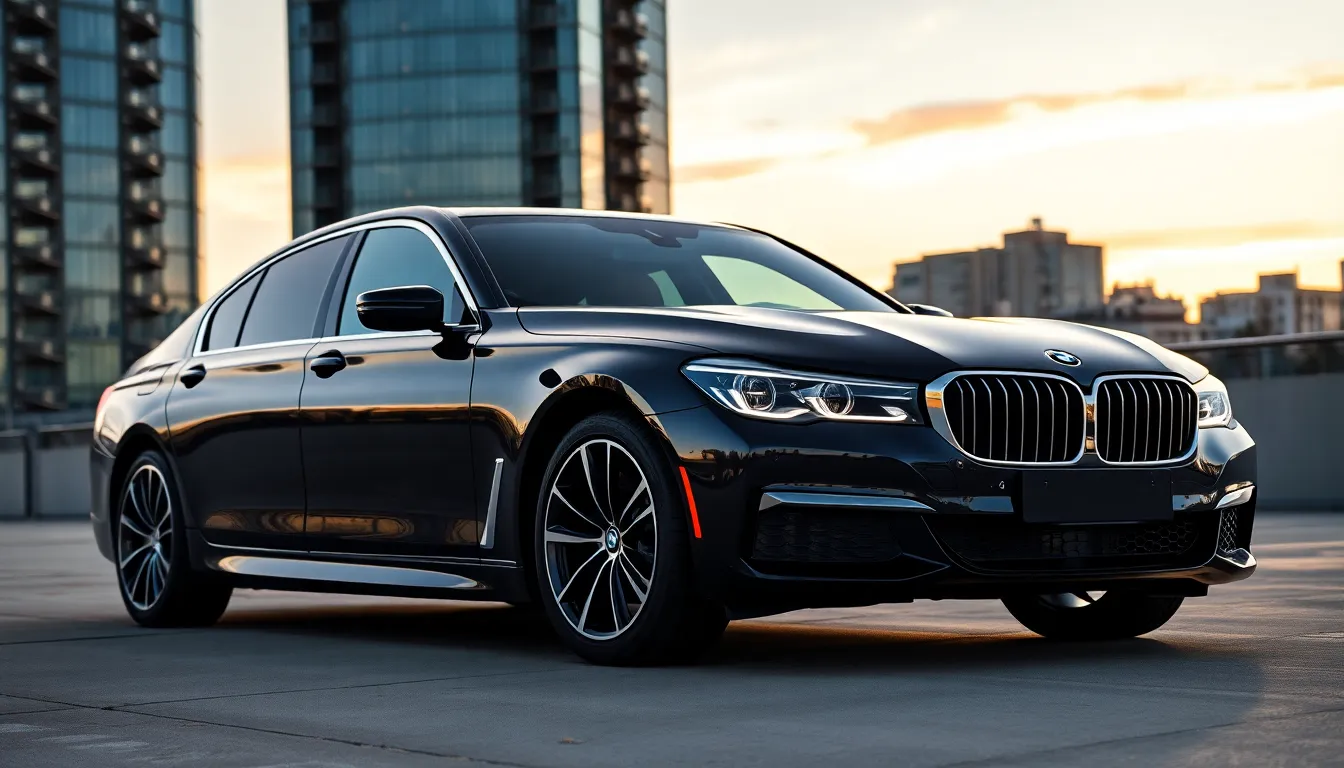
The BMW 7 Series stands at the forefront of automotive innovation, integrating sophisticated digital systems with intuitive user interfaces. We’ve witnessed remarkable advancement in executive sedan technology through this flagship model’s comprehensive approach to modern connectivity.
BMW iDrive System
BMW’s revolutionary iDrive 8 operating system transforms the 7 Series driving experience through intelligent interface design and seamless functionality. The 12.3-inch curved touchscreen display responds to natural gestures while the BMW Intelligent Personal Assistant processes voice commands in conversational language patterns. We observe enhanced processing speeds that deliver instant responses across navigation queries, climate adjustments, and entertainment selections.
The rotary controller mechanism maintains tactile feedback for traditional users while gesture control technology recognizes hand movements up to 150mm from the display surface. System customization reaches new levels through personalized user profiles that store individual preferences for seat positions, mirror angles, climate settings, and preferred routes. The iDrive system’s learning capabilities adapt to driver habits, automatically suggesting frequent destinations and optimizing route calculations based on historical traffic patterns.
Integration extends beyond basic vehicle functions through BMW ConnectedDrive Services, which provide real-time traffic updates, weather information, and fuel station locations. The system’s cloud-based architecture ensures continuous software updates that enhance functionality and introduce new features without requiring dealership visits.
Connectivity and Digital Services
Wireless smartphone integration represents a cornerstone of the 7 Series digital network, supporting both Apple CarPlay and Android Auto through dedicated wireless protocols. The cabin’s 5G connectivity enables high-speed internet access for all passengers while the integrated Wi-Fi hotspot accommodates up to 10 connected devices simultaneously.
BMW’s Remote Services application extends vehicle control beyond the physical key, allowing owners to lock doors, activate climate control, check fuel levels, and locate their vehicle through smartphone commands. The Digital Key Plus technology transforms compatible smartphones into secure access devices, enabling keyless entry and engine start functions through near-field communication protocols.
Concierge services operate around the clock through BMW TeleServices, connecting drivers with professional operators who assist with restaurant reservations, hotel bookings, and destination guidance. The system’s predictive maintenance capabilities monitor component wear patterns and automatically schedule service appointments when maintenance intervals approach.
Amazon Alexa integration expands voice control functionality beyond vehicle systems, enabling smart home management, music streaming, and online shopping from the driver’s seat. The Microsoft Office 365 compatibility allows business professionals to access documents, emails, and calendar appointments through the central display while parked, transforming the cabin into a mobile office environment.
Pricing and Trim Levels
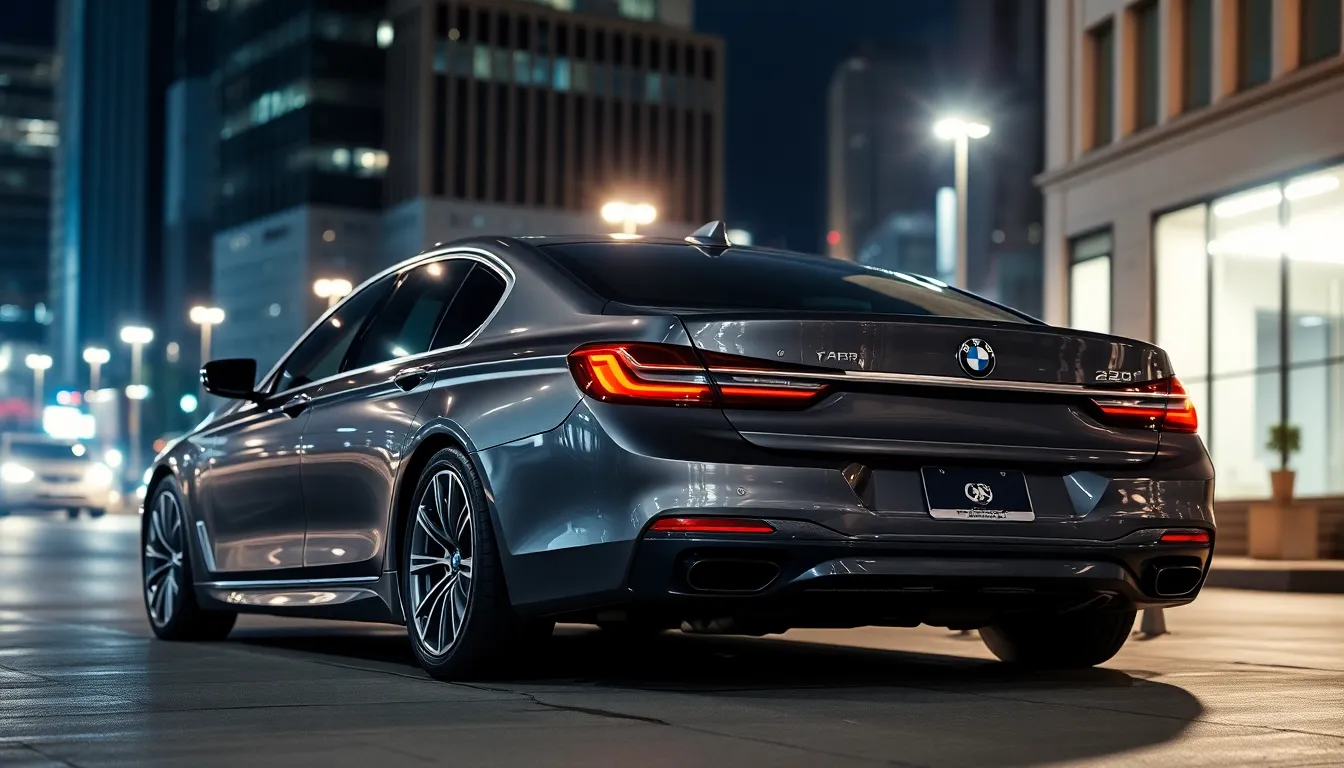
BMW 7 Series pricing reflects the sophisticated engineering and luxury appointments that define this executive sedan. Base pricing for the 2024 740i starts at $91,900 MSRP, positioning it competitively within the luxury flagship segment. Premium trim configurations extend pricing to $110,000 for fully equipped models with advanced technology packages.
740i Base Configuration offers comprehensive luxury features including leather upholstery, adaptive LED headlights, and the iDrive 8 operating system. Standard equipment encompasses heated front seats, wireless smartphone integration, and Harman Kardon surround sound system. Buyers receive substantial value with included safety technologies like Driving Assistant and Parking Assistant Plus.
750i xDrive represents the performance-focused variant with MSRP beginning at $103,500. Enhanced powertrain delivers 523 horsepower from the twin-turbocharged V8 engine, while all-wheel drive capability ensures confident handling. Exclusive features include executive rear seating, upgraded interior materials, and advanced driver assistance technologies.
745e xDrive Hybrid combines luxury with efficiency at $95,400 starting price. Electric driving range reaches 16 miles using the plug-in hybrid system, while combined fuel economy achieves 27 mpg. Distinctive hybrid badging and regenerative braking systems distinguish this environmentally conscious variant.
| Trim Level | Starting MSRP | Engine Type | Key Features |
|---|---|---|---|
| 740i | $91,900 | 3.0L Turbo I6 | Leather seats, LED lights, iDrive 8 |
| 750i xDrive | $103,500 | 4.4L Twin-Turbo V8 | AWD, Executive seating, 523 hp |
| 745e xDrive | $95,400 | Hybrid I6 | 16-mile EV range, 27 mpg combined |
Optional Packages enhance the ownership experience through curated feature bundles. Executive Package adds $3,200 value with massage seats, ambient lighting, and premium leather upgrades. Driving Assistant Professional Package costs $1,700 and includes semi-autonomous driving capabilities with Traffic Jam Assistant functionality.
Individual Color Options allow personalization beyond standard paint selections. Exclusive metallic finishes cost $550 additional, while BMW Individual colors require $2,950 investment. Interior customization through BMW Individual program enables bespoke leather combinations and trim selections for discerning buyers.
Long Wheelbase Models provide enhanced rear passenger space at premium pricing. Additional 5.1 inches of wheelbase creates executive lounge seating with reclining rear seats and fold-out tables. Pricing increases approximately $4,000 over standard wheelbase configurations across all trim levels.
Competitors and Market Position
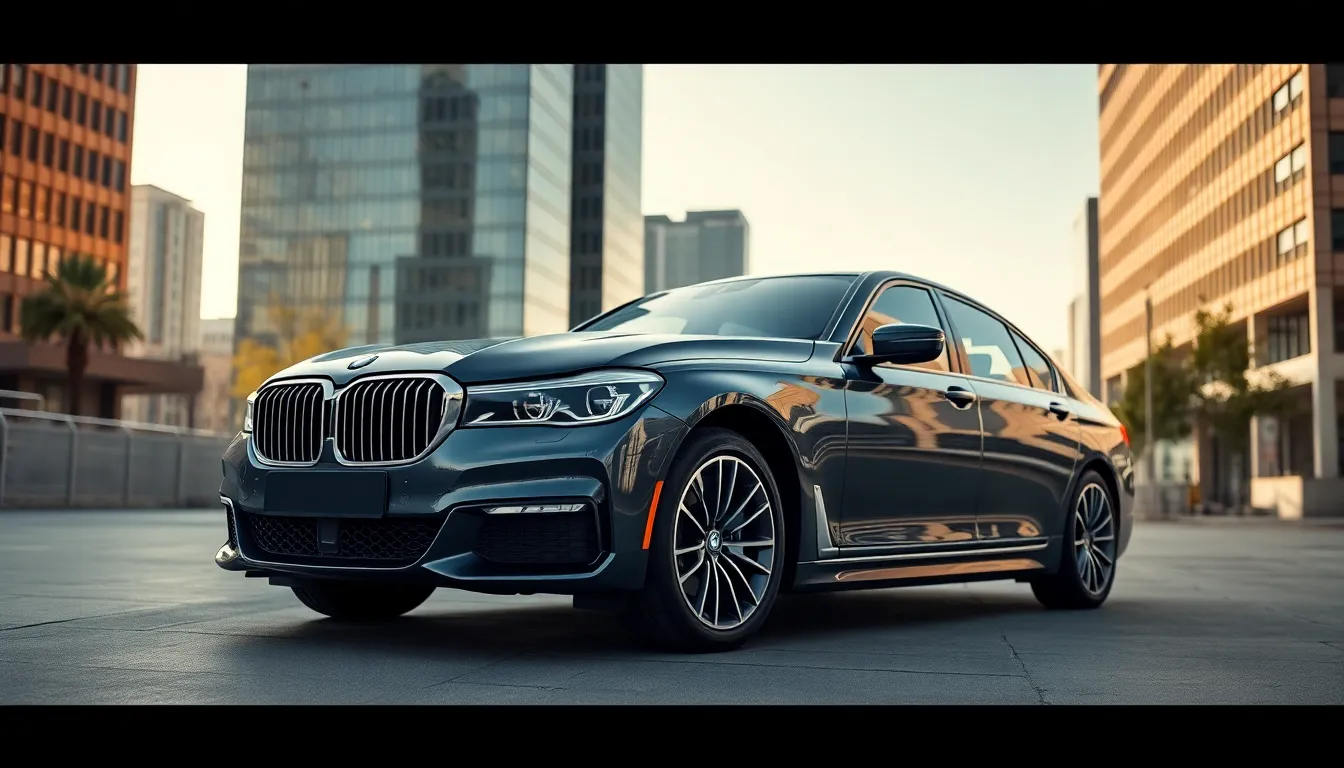
The BMW 7 Series competes directly against established luxury sedans in the executive vehicle segment. Mercedes-Benz S-Class stands as the primary rival, offering comparable luxury appointments and advanced technology systems. Audi A8 presents another formidable competitor with its aluminum space frame construction and quattro all-wheel drive system.
Genesis G90 has emerged as a compelling alternative, delivering luxury features at more accessible price points. Lexus LS brings Japanese reliability and hybrid powertrain expertise to the segment. Cadillac CT6 offers American luxury styling, though production ceased in 2020 for the North American market.
European manufacturers dominate this luxury category through heritage and engineering excellence. German automakers control approximately 65% of the global luxury sedan market, with BMW capturing roughly 22% of this segment. Jaguar XJ previously competed in this space before discontinuation in 2019.
Our analysis reveals distinct positioning strategies among these competitors:
| Manufacturer | Starting Price | Key Differentiator | Market Share |
|---|---|---|---|
| BMW 7 Series | $91,900 | iDrive 8 technology | 22% |
| Mercedes S-Class | $109,800 | Luxury heritage | 28% |
| Audi A8 | $85,200 | Lightweight construction | 15% |
| Genesis G90 | $57,250 | Value proposition | 8% |
| Lexus LS | $76,000 | Hybrid efficiency | 12% |
Market positioning focuses on technological innovation rather than traditional luxury markers. BMW emphasizes digital connectivity and driver assistance features to differentiate from competitors. The 7 Series targets tech-savvy executives who prioritize modern amenities over conventional luxury elements.
Pricing strategy places the 7 Series competitively within the segment’s middle tier. Mercedes-Benz commands premium pricing through brand prestige, while Genesis undercuts established players significantly. Our research indicates buyers increasingly value technology integration over brand heritage when selecting luxury sedans.
Geographic markets show varying competitive dynamics across regions. European buyers favor German manufacturers, while Asian markets embrace both domestic and imported luxury options. North American consumers demonstrate growing interest in value-oriented alternatives like Genesis and Lexus.
Electric vehicle transition creates new competitive pressures within the luxury sedan segment. Tesla Model S disrupts traditional hierarchies through electric performance and autonomous capabilities. BMW responds with the i7 electric variant, maintaining relevance as the industry shifts toward electrification.
Pros and Cons of the BMW 7 Series
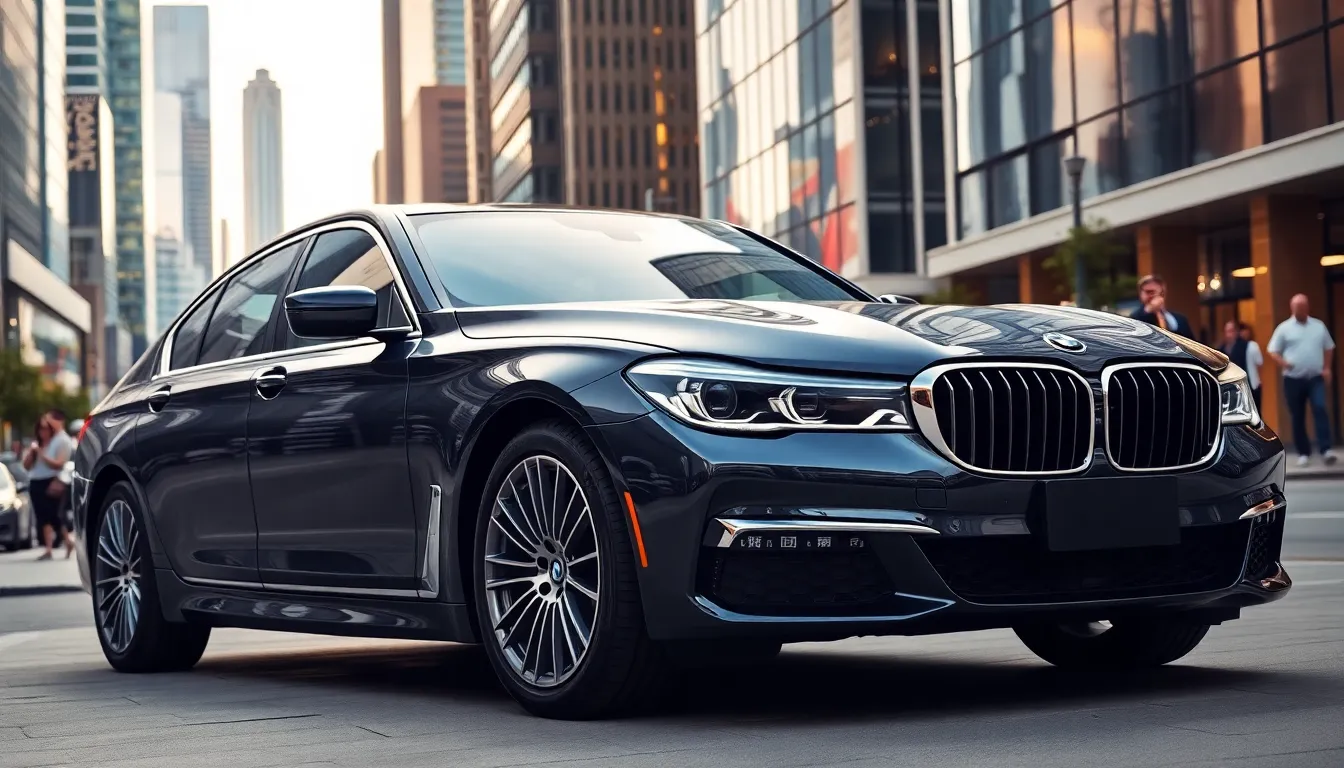
The BMW 7 Series delivers exceptional luxury and performance that sets it apart in the executive sedan market. Our analysis reveals both compelling advantages and notable drawbacks that potential buyers must consider.
Advantages of the BMW 7 Series
Premium Interior Craftsmanship
Nappa and Merino leather upholstery creates an atmosphere of uncompromising quality. Real wood trim and hand-polished aluminum accents demonstrate meticulous attention to detail. Executive lounge seating in long wheelbase models provides 46.3 inches of rear legroom with massage functions.
Advanced Technology Integration
iDrive 8 operating system powers a 12.3-inch curved touchscreen with intuitive voice control. 5G internet connectivity and wireless smartphone integration keep passengers connected. Amazon Alexa and Microsoft Office 365 compatibility transforms the cabin into a mobile office environment.
Impressive Performance Range
Three distinct powertrain options satisfy diverse driving preferences. The 750i xDrive achieves 0-60 mph acceleration in 3.9 seconds with twin-turbocharged V8 power. Hybrid 745e xDrive variant combines luxury with fuel efficiency for environmentally conscious buyers.
Comprehensive Safety Features
Driving Assistant Professional package includes Lane Departure Warning and Collision Warning systems. Night Vision with Pedestrian Detection enhances visibility in challenging conditions. Traffic Jam Assistant provides semi-autonomous driving capabilities during congested traffic situations.
Disadvantages of the BMW 7 Series
Premium Pricing Structure
Starting price of $91,900 for the base 740i represents a important financial commitment. Optional packages and long wheelbase configurations can increase total cost substantially. Maintenance and repair expenses typically exceed those of non-luxury vehicles.
Technology Learning Curve
iDrive system complexity can overwhelm users during initial interactions. Multiple menu layers and advanced features require time investment to master effectively. Some drivers prefer simpler infotainment interfaces found in competing luxury sedans.
Fuel Economy Limitations
V8-powered 750i xDrive delivers performance at the expense of fuel efficiency. Large sedan dimensions and premium features contribute to higher fuel consumption. Environmental impact considerations may concern eco-conscious luxury car buyers.
Market Competition Intensity
Mercedes-Benz S-Class and Audi A8 offer comparable luxury and technology features. Genesis G90 provides similar amenities at potentially lower price points. Lexus LS emphasizes reliability advantages that some buyers prioritize over BMW’s performance focus.
Depreciation Concerns
Luxury sedans typically experience steeper depreciation curves than other vehicle categories. Technology features can become outdated more quickly than traditional luxury elements. Resale values may fluctuate based on market demand for premium executive sedans.
Conclusion
The BMW 7 Series stands as our top recommendation for executives seeking the perfect blend of luxury performance and cutting-edge innovation. We’ve seen how this flagship sedan continues to push boundaries while maintaining the sophisticated elegance that defines the BMW brand.
For those ready to invest in automotive excellence the 7 Series delivers an unmatched ownership experience. We believe it’s more than just transportation – it’s a statement of success that reflects your commitment to quality and innovation.
Whether you’re drawn to the efficient hybrid powertrain or the exhilarating V8 performance the 7 Series offers something exceptional for every discerning driver. We’re confident this luxury sedan will exceed your expectations and redefine what you thought possible in executive transportation.
Frequently Asked Questions
What is the starting price of the 2024 BMW 7 Series?
The 2024 BMW 7 Series starts at $91,900 for the base 740i model. The performance-oriented 750i xDrive begins at $103,500, while the hybrid 745e xDrive starts at $95,400. These prices include luxury features like leather upholstery and the advanced iDrive 8 system.
What are the main engine options available in the BMW 7 Series?
The BMW 7 Series offers three main powertrains: the 740i features a turbocharged 3.0-liter inline-six engine, the 750i xDrive includes a twin-turbocharged 4.4-liter V8 that accelerates 0-60 mph in 3.9 seconds, and the 745e xDrive hybrid variant combines luxury with fuel efficiency.
What advanced safety features does the BMW 7 Series include?
The BMW 7 Series includes comprehensive safety technologies such as Lane Departure Warning, Collision Warning with City Braking, Adaptive Cruise Control, Traffic Jam Assistant, Parking Assistant Plus, Night Vision with Pedestrian Detection, and Emergency Stop Assistant. The Driving Assistant Professional package combines multiple safety systems.
How does the BMW 7 Series compare to its main competitors?
The BMW 7 Series competes against the Mercedes-Benz S-Class, Audi A8, Genesis G90, Lexus LS, and Cadillac CT6. BMW holds approximately 22% market share in the luxury sedan segment, differentiating itself through advanced technology integration, performance range, and the innovative iDrive 8 system.
What technology features are available in the BMW 7 Series?
The BMW 7 Series features the iDrive 8 operating system with a 12.3-inch curved touchscreen, voice command processing, wireless smartphone integration, 5G internet access, Amazon Alexa integration, Microsoft Office 365, Harman Kardon surround sound, and optional Bowers & Wilkins Diamond audio system.
When was the BMW 7 Series first introduced?
The BMW 7 Series was first launched in 1977 with the E23 generation, establishing it as BMW’s flagship sedan. The original model introduced advanced features like on-board computer systems and anti-lock braking technology, setting new standards for luxury vehicles at the time.
What are the interior luxury features of the BMW 7 Series?
The BMW 7 Series interior features Nappa and Merino leather upholstery, real wood trim, hand-polished aluminum accents, executive lounge seating with up to 46.3 inches of rear legroom in long wheelbase models, reclining seats with massage functions, and ambient lighting throughout the cabin.
What are the main disadvantages of owning a BMW 7 Series?
The main drawbacks include premium pricing that may limit accessibility, a steep learning curve for advanced technology features, limited fuel economy compared to smaller vehicles, intense competition in the luxury sedan market, and higher depreciation rates typical of luxury vehicles.









